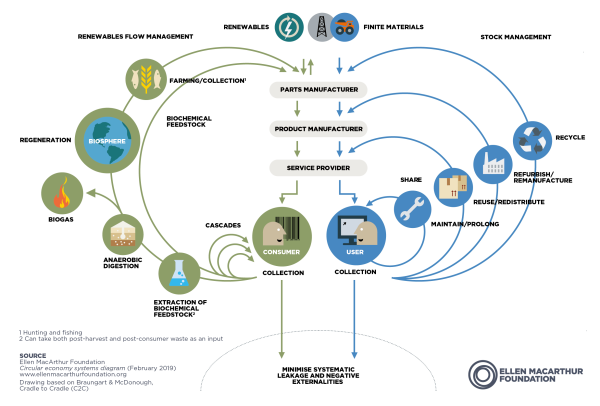Circulair economy
The circular economy
The circular economy can be an important instrument to tackle the current triple planetary crises on climate, biodiversity and pollution. By keeping resources in the loop for longer, we'll avoid emitting greenhouse gases caused by the energy needed to make products.
What is the circular economy?
In theorie
The circular economy is a systems solution framework that tackles global challenges like climate change, biodiversity loss, waste, and pollution.
Th European Union produces more than 2,5 billion tonnes of waste every year. Making a shift to circulair economy would help for a lot of issues around climate change, biodiversity loss, waste and pollution. A circulair economy is a model of production and consumption that involves:
- Sharing
- Leasing
- Reusing
- Repairing
- Refurbishing
- Recycling
With using this model the life cycle of a product is extended.
In practice
In practice using the circular economy implies reducing waste. When a product ends its life cycle, the materials will be kept in the economy. Therefore the life cycle of a product is circular. Instead of cheap materials and products that are easily thrown away, materials that are more expensive and efficient to recycle, reuse, repair etc are becoming more expensive.
Why is it important to have a circular economy
There are multiple reasons why using a circular economy instead of a linear economy is important. A few are mentioned here.
- The supply of raw materials becomes smaller and our economy depends on the raw materials. This means that if we do not have excess to raw materials our economy will collapse. Making our economy less dependent on these limited resources is very important to have a healthy economy. When we only use materials that can be recycled infinitely, we do not need to extract new materials.
- The raw materials used for most of our products have a negative impact on our environment. As well as extracting and using these materials have a negative impact on our environment. For example, petroleum-based plastics are made from petroleum and or petroleum by-products. The process of extracting and making these plastics has a very negative impact on the environment. Once the plastic is made and used the plastic still releases carbon dioxide when the plastic is degrading, melting or being recycled.
- With a circular economy we have less pollution in the environment. Banding single-used plastics results in less pollution in the environment. Once we have a fully circular economy, pollution should be minimized.
